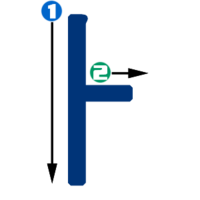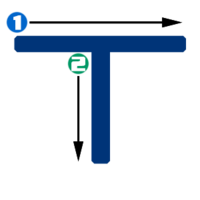Difference between revisions of "Hangeul step 2"
DigitalSoju (Talk | contribs) (→Real Examples) |
(→Introduction: Checked most punctuation for consistency; Added links to the jamo at the beginning of the page; Slight rewording of the present text) |
||
| Line 11: | Line 11: | ||
In this lesson, you will learn: | In this lesson, you will learn: | ||
| − | *Consonants: ㄱ, ㄴ, ㅁ, ㄷ, ㅇ | + | *Consonants: [[ㄱ]], [[ㄴ]], [[ㅁ]], [[ㄷ]], [[ㅇ]] |
| − | *Vowels: ㅏ, ㅜ, ㅗ, ㅣ | + | *Vowels: [[ㅏ]], [[ㅜ]], [[ㅗ]], [[ㅣ]] |
| Line 19: | Line 19: | ||
|Consonant = ㄱ | |Consonant = ㄱ | ||
|Cons image = ㄱ.jpg | |Cons image = ㄱ.jpg | ||
| − | |Cons text = This is pronounced like a mix between a g and a k at the beginning of a word, | + | |Cons text = This is pronounced like a mix between a g and a k at the beginning of a word. However, when found between vowels, the sound is voiced and makes a /g/ sound. For full information about this letter, see [[ㄱ]]. |
|Vowel = ㅏ | |Vowel = ㅏ | ||
|Vowel image = ㅏ.jpg | |Vowel image = ㅏ.jpg | ||
| Line 46: | Line 46: | ||
|Vowel = ㅜ | |Vowel = ㅜ | ||
|Vowel image = ㅜ.jpg | |Vowel image = ㅜ.jpg | ||
| − | |Vowel text = This sound makes "ooh" sound, similar to 'm'''oo'''n' or 'bl'''ue'''' or the U sound in Spanish (i.e. '''u'''sted). For full information about this letter, see [[ㅜ]]. | + | |Vowel text = This sound makes "ooh" sound, similar to 'm'''oo'''n' or 'bl'''ue'''' or the U sound in Spanish (i.e. '''u'''sted in "usted"). For full information about this letter, see [[ㅜ]]. |
|Vowel audio description1 = Male | |Vowel audio description1 = Male | ||
|Vowel audio1 = <flashmp3>u H.mp3|leftbg=003478|rightbg=c60c30|lefticon=ffffff|righticon=ffffff</flashmp3> | |Vowel audio1 = <flashmp3>u H.mp3|leftbg=003478|rightbg=c60c30|lefticon=ffffff|righticon=ffffff</flashmp3> | ||
| Line 108: | Line 108: | ||
|Consonant = ㄷ | |Consonant = ㄷ | ||
|Cons image = ㄷ.jpg | |Cons image = ㄷ.jpg | ||
| − | |Cons text = This is pronounced like a mix between a t and a d at the beginning of a word, | + | |Cons text = This is pronounced like a mix between a t and a d at the beginning of a word. However, when found between vowels, the sound is voiced and makes a /d/ sound. For full information about this letter, see [[ㄷ]]. |
|Vowel = ㅣ | |Vowel = ㅣ | ||
|Vowel image = ㅣ.jpg | |Vowel image = ㅣ.jpg | ||
| − | |Vowel text = This sound is similar to 'ee' sound in 's'''ee'''' or 'fr'''ee'''.' For full information about this letter, see [[ㅣ]]. | + | |Vowel text = This sound is similar to the 'ee' sound in 's'''ee'''' or 'fr'''ee'''.' For full information about this letter, see [[ㅣ]]. |
|Vowel audio description1 = Male | |Vowel audio description1 = Male | ||
|Vowel audio1 = <flashmp3>i H.mp3|leftbg=003478|rightbg=c60c30|lefticon=ffffff|righticon=ffffff</flashmp3> | |Vowel audio1 = <flashmp3>i H.mp3|leftbg=003478|rightbg=c60c30|lefticon=ffffff|righticon=ffffff</flashmp3> | ||
| Line 148: | Line 148: | ||
|char = ㅇ (consonant) | |char = ㅇ (consonant) | ||
|Image = ㅇ.jpg | |Image = ㅇ.jpg | ||
| − | |Text = ㅇ | + | |Text = ㅇ represents no sound when found in the initial position of a syllable. Instead, it simply acts as a placeholder since <u>vowels can't be written by themselves</u>. However, if ㅇ is in the final (bottom) position, it makes an "ng" sound, i.e. 'si'''ng'''' or 'wro'''ng'''' ([[IPA]]: ŋ ), but these final position sounds won't be discussed until [[Hangeul_step_5|step 5]] of this lesson. For now, just think of it as a placeholder for a consonant when only a vowel sound must be written. For full information about this letter, see [[ㅇ]]. <!--Insert picture--> |
|Bgcolor = {{Kred}} | |Bgcolor = {{Kred}} | ||
|Audio description1 = | |Audio description1 = | ||
Revision as of 06:41, 21 February 2010
|
|
|
| Help · Cheat Sheet · Community portal |

|

|
Contents
Introduction
Since consonants can't be pronounced without the help of a vowel, we have decided to teach you the vowel first, then pair it with a consonant. Note some of these files are set to loop, so you must manually stop the files yourself.
In this lesson, you will learn:
|
| ||||||||||
|
For full information about this letter, see ㅏ.
|
This is pronounced like a mix between a g and a k at the beginning of a word. However, when found between vowels, the sound is voiced and makes a /g/ sound. For full information about this letter, see ㄱ. | ||||||||||
| Practice | |
|---|---|
| 가 | |
|
| ||||||||||
|
This sound makes "ooh" sound, similar to 'moon' or 'blue' or the U sound in Spanish (i.e. usted in "usted"). For full information about this letter, see ㅜ.
|
This sound is the same as the N sound in English. For full information about this letter, see ㄴ. | ||||||||||
| Practice | |
|---|---|
| 누 | |
| 나 | |
| 구 | |
|
| ||||||||||
|
For full information about this letter, see ㅗ.
|
This sound is the same as the M sound in English. For full information about this letter, see ㅁ. | ||||||||||
| Practice | |
|---|---|
| 모 | |
| 마 | |
| 무 | |
| 고 | |
| 노 | |
|
| ||||||||||
|
This sound is similar to the 'ee' sound in 'see' or 'free.' For full information about this letter, see ㅣ.
|
This is pronounced like a mix between a t and a d at the beginning of a word. However, when found between vowels, the sound is voiced and makes a /d/ sound. For full information about this letter, see ㄷ. | ||||||||||
| Practice | |
|---|---|
| 디 | |
| 다 | |
| 두 | |
| 도 | |
| 기 | |
| 니 | |
| 미 | |
| ||||
|
ㅇ represents no sound when found in the initial position of a syllable. Instead, it simply acts as a placeholder since vowels can't be written by themselves. However, if ㅇ is in the final (bottom) position, it makes an "ng" sound, i.e. 'sing' or 'wrong' (IPA: ŋ ), but these final position sounds won't be discussed until step 5 of this lesson. For now, just think of it as a placeholder for a consonant when only a vowel sound must be written. For full information about this letter, see ㅇ. | ||||
| Practice | |
|---|---|
| 아 | |
| 우 | |
| 오 | |
| 이 | |
Real Examples
| Word | Audio |
|---|---|
| 가구 (furniture) | |
| 가나다 (Korean alphabet, i.e. abc) | |
| 가다 (to go) | |
| 가두다 (to lock in) | |
| 고구마 (sweet potato) | |
| 고기 (meat) | |
| 고모 (father's sister) | |
| 구두 (dress shoes) | |
| 기도 (prayer) | |
| 나가다 (go out) | |
| 나누다 (to divide) | |
| 나무 (tree) | |
| 나오다 (to come out) | |
| 나이 (age) | |
| 누가 (who) | |
| 누구 (who) | |
| 누나 (older sister) | |
| 다가가다 (approach to someone) | |
| 다니다 (to go to, work, school etc) | |
| 도구 (instrument,tool) | |
| 마다 (every) | |
| 마디 (joint, knot) | |
| 모기 (mosquito) | |
| 아기 (baby) | |
| 아마도 (maybe,perhaps) | |
| 아우 (man's younger brother-but not used anymore) | |
| 아이 (child) | |
| 오다 (to come) | |
| 오이 (cucumber) | |
| 이기다 (to win) | |
| 이모 (mother's sister) |
Writing
Characters are written in a certain stroke order. Korean letters are written left to right, top to bottom.

|

|


















